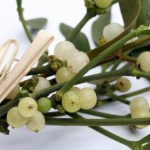Mistletoe
Ever since the beginning of this blog, there's one topic I've explored many, many times, mainly because of its direct relationship to my profession as a cancer surgeon. That topic is, of course, the question of why people fall for alternative medicine cancer "cures." It started with one of my very earliest posts and continued right up to deconstructing Presidential candidate Ben Carson's very own alternative medicine cancer cure testimonial last fall. It continues again now.
Regular readers, particularly long time readers, have already come to recognize common themes in these alternative…
Ok, I kind of covered this parasite earlier this year. In that post, I explained that Mistletoe is a hemi-parasite (only partially dependent on its host for survival) and that the family represents one of the nine times that parasitism evolved in the plant kingdom. I also mentioned that unlike most parasites, parasitic plants are keystone species, where their ecological impact is disproportionate relative to their abundance. But I didn't talk about the many varieties of mistletoe, and this time, I'd like to focus on one: dwarf misteletoe, of the genus Arceuthobium.
Recently, the dwarf…
So I've had unicellular parasites, metazoan parasites, even fungi parasites featured every week here. But there is one kind of parasite I haven't talked about: parasitic plants.
The classic example of a parasitic plant is the ever-loved Christmas favorite: Mistletoe. "Mistletoe" is actually a fairly large group of hemi-parasitic plants in the order Santalales. They're called "hemi-parasites" because, in fact, they can produce some of their own food and nutrients, and aren't 100% dependent on their hosts for survival.
Mistletoe is dependent upon birds to spread from host to host. The berries…
